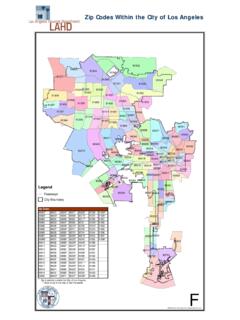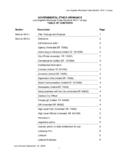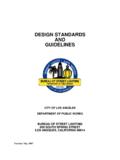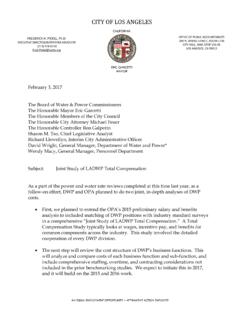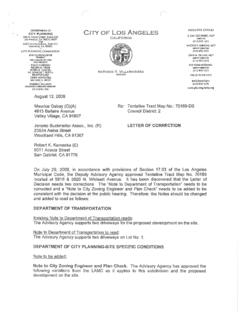Transcription of City of Los Angeles - lacitysan.org
1 city OF LOS Angeles Sewer System Management Plan (SSMP) Biennial Self-Audit Report Pursuant to the State General Waste Discharge Requirements (WDRs) Order No. SSS WDRs 2006-0003 February 2017 city of Los Angeles | 1 city of Los Angeles Bureau of Sanitation Sewer System Management Plan Biennial Self-Audit Report February 2017 city of Los Angeles | 2 Table of Content 1. Purpose and Background 3 2. Self-Audit Method and Scope 5 3. Self-audit Findings 5 a. Broad Evaluation 5 b. More Detailed Findings 9 4. Recommendations 14 city of Los Angeles | 3 1. Purpose and Background This Audit Report was prepared by LA Sanitation in accordance with the requirements of Paragraph (x) of the California State General Waste Discharge Requirements (WDRs).
2 The purpose of this audit is to review the city s Sewer System Management Plans (SSMPs) for compliance with the WDRs and effectiveness in controlling and mitigating Sanitary Sewer Overflows (SSOs). Paragraph (X) of WDRs states: SSMP Program Audits - As part of the SSMP, the Enrollee shall conduct periodic internal audits, appropriate to the size of the system and the number of SSOs. At a minimum, these audits must occur every two years and a report must be prepared and kept on file. This audit shall focus on evaluating the effectiveness of the SSMP and the Enrollee s compliance with the SSMP requirements identified in this subsection ( ), including identification of any deficiencies in the SSMP and steps to correct them. Pursuant to WDRs Paragraph , LA Sanitation prepared a SSMP for each of the city s three Sanitary Sewer Systems which were approved by the Board of Public Works in February 2009.
3 A self-audit report on the city s SSMPs is, therefore, due no later than February of each odd year following the Board of Public Works adoption of the original SSMP in 2009. In addition, Paragraph of WDRs states that: .. The SSMP must be updated every five (5) years, and must include any significant program changes. Re-certification by the governing board of the Enrollee is required in accordance with when significant updates to the SSMP are made.. Accordingly, the Board of Public Works adopted a Five-year Update of the SSMPs in February 2014. The next Five-year Update will be due in February 2019. The following is a brief overview of the city s three Sanitary Sewer Systems. Hyperion Sanitary Sewer System: The Hyperion System is by far the largest of the city s sanitary sewer systems, including 6,117 miles of gravity sewer and 24 miles of force main.
4 Currently an average wastewater flow rate of nearly 300 million gallons per day (MGD) is generated in the System. About 70 MGD is treated at upstream Donald C. Tillman and Los- Angeles Glendale Water Reclamation Plants. All other flow in the System and the bio-solids from these city of Los Angeles | 4 reclamation plants are treated at the Hyperion Treatment Plant located in Playa Del Rey. Terminal Island Water Reclamation Plant Sanitary Sewer System: The plant currently processes an average wastewater flow rate of 15 million gallons per day that is collected and conveyed to the plant by 318 miles of gravity sewer and 13 miles of force main. The city of Los Angeles Regional Sanitary Sewer System: The service area consists of 113 miles of gravity sewer and one (1) mile of force main. Wastewater generated in this service area is treated at the County Sanitation Districts Joint Water Pollution Control Plant in Carson.
5 city of Los Angeles | 5 2. Self-Audit Method and Scope An audit questionnaire was prepared and key personnel in the city s Clean Water Program were interviewed. All Parts and Sub-parts of the SSMPs were evaluated with respect to compliance with WDRs and their effectiveness in helping meet the SSMP Goals as set forth in SSMP Part I. The SSMP elements which have been determined to be WDR-compliant and effective will continue to be implemented. Recommendations are made for the SSMP elements which have been determined to be in need of an update or enhancement. In addition, in light of the requirement to prepare the next Five-year Update of the SSMPs by February 2019 pursuant to WDRs Paragraph , this Audit Report will include a recommendation for a more extensive review and update of the SSMPs to be completed in February 2019, as described in Section 4, Audit Recommendations.
6 3. Self-audit Findings The WDRs require that the biennial self-audits focus on (1) the SSMPs continued compliance with WDRs, and (2) effectiveness in controlling and mitigating sewer overflows. The following will provide an overall evaluation report followed by a more detailed report on the SSMPs individual Parts and Sub-parts. a. Broad Evaluation (1) Compliance with WDRs The city s SSMPs continue to be in full compliance with the provisions of the WDRs. The SSMPs contain all WDRs-required parts and subparts, are being implemented, and are communicated to staff and the public via the internet and LA Sanitation s intranet and other means. (2) Effectiveness in Controlling Sanitary Sewer Overflows During this audit cycle, except for one major sewer collapse which resulted in high-volume Category1 SSOs that reached surface waters, all SSMP goals have been met.
7 In Fiscal Years 2014/15 and 2015/16, the number of SSOs were a total of 110 and 102, respectively, for all three of the city s Systems combined, or less than two (2) SSOs per year per 100 miles of sewer pipes, far below the State and National average. The volume of SSOs during the past two years, however, has been uncharacteristically high due to a major collapse of the North Outfall Sewer (NOS) in July 2016 which resulted in a number of Category 1 SSOs city of Los Angeles | 6 that reached surface waters. The city has taken measures to mitigate impact and is planning and implementing preventive measures to avoid similar future occurrence, in full communication with the Los Angeles Regional Water Quality Control Board. The following are some of the highlights of accomplishments in the past two Fiscal Years. Inspected 764 miles of sewer using CCTV.
8 Completed 64 miles of rehabilitation and replacement projects. Cleaned more than 14,000 miles as a part of preventive maintenance program. Chemically treated 731miles for root control. Annually inspected all of the nearly 10,000 food service establishments (FSEs) for compliance with the FOG Control Program Ordinance. city of Los Angeles | 7 Overall SSOs Figures shown are totals for all three Sanitary Sewer Systems combined. city of Los Angeles | 8 FOG-Related SSO Reduction Figures shown are totals for all three Systems combined. city of Los Angeles | 9 Root-Caused SSO Reduction Figures shown are totals for all three Systems combined. b. More Detailed Findings on Individual SSMP Parts and Sub-parts The following are the findings of this Self-audit Report with respect to WDRs compliance and effectiveness in controlling and mitigating SSOs in greater details.
9 For each SSMP part and subpart, two key questions have been addressed: (1) Does it continue to comply with the requirements of the WDRs and any amendments thereto, and (2) Does it continue to be effective and efficiently support the SSMP objectives to control and mitigate sewer overflows. Recommendations are provided for improvement if these questions could not be answered affirmatively. A questionnaire was used to verify the prevalence and accuracy of each SSMP part and sub-part. Recommended action is noted where an element of the SSMP is found to be no longer current or accurate. city of Los Angeles | 10 Part i, Goal Are the goals included in Part I still appropriate and accurate? Yes. Part ii, Organization Are the city s Clean Water Program s organization and staff contact information included in Part II up-to-date and effective?
10 The names and contact information of the city offices having a lead or support role in the policy making, management, operation, and maintenance of the sanitary sewer systems are largely current and accurate. There are a few exceptions. For example, some offices names have been changed to more accurately reflect their current responsibilities and functions which will be included with the updated SSMPs when the recommended revisions are incorporated. Recommendations: None for this biennial cycle. Consider conducting a review of the city s Clean Water Program s organization with the aim to maximize the advantages that are or should be realized due to overlaps and redundancies as a part of the next Five-year Update which is due by February 2019. Part III, Legal Authority (a) Are the city ordinances for illicit discharge prevention and Inflow/Infiltration (I/I) control still current and accurate?


